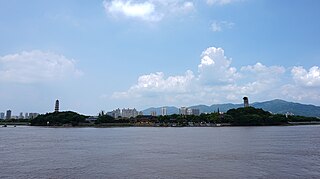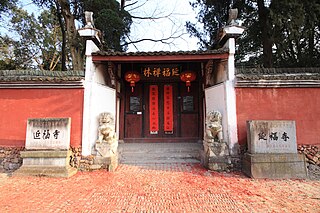
Lishui (help·info) is a prefecture-level city in the southwest of Zhejiang province, People's Republic of China. It borders Quzhou, Jinhua and Taizhou to the north, Wenzhou to the southeast, and the province of Fujian to the southwest. The name of the city literally means "Beautiful Water", but the pronunciation of its first character is "lí", not the usual "lì".

Shangcheng District is a core urban district of Hangzhou, the capital of Zhejiang province, in the People's Republic of China. It has an area of 18 square kilometers (6.9 sq mi) and a population of 310,000. Its postal codes include 310001, 310002, 310003, 310006, 310008, 310009, and 310016.

Guiyuan Temple is a Buddhist temple located on Cuiwei Rd. of Hanyang district in Wuhan City, Hubei Province of China.

The Women's Hospital School of Medicine Zhejiang University is a hospital specialized for women in Hangzhou, Zhejiang Province, People's Republic of China.
Zhejiang Provincial College of Medicine, was a medical college for higher education in Hangzhou, Zhejiang Province, China. It was one of main roots for the current School of Medicine, Zhejiang University (浙江大學醫學院/浙江大学医学院).
Han Qingquan was a Chinese doctor, educator and pioneer of modern medical service and public health in China.

A Major Historical and Cultural Site Protected at the National Level, often abbreviated as guobao, is one of 4,295 monuments listed as of significant historical, artistic or scientific value by the State Administration of Cultural Heritage, which is the cultural relics administrative department of the State Council of China. Selected among Sites Protected at lower levels, Sites Protected at the National Level are lawfully the monuments with protection of the highest level in China. It is prohibited to demolish them. An approval by the State Administration of Cultural Heritage is required before a potential removal of such sites.
Qiu Shi Prizes are awarded on an annual basis in recognition of advances in science and technology. The Qiu Shi Science and Technology Foundation was established by Mr. Cha Chi Ming 查濟民 (1914-2007) in 1994 in Hong Kong, with the intention of promoting science and technology research in China, and to encourage and reward successful Chinese scientists and scholars. Prizes are awarded each year Prize categories include Physics, Chemistry, Physiology or Medicine, Mathematics or Information Technology.

The Eastern Zhejiang Canal is located in Zhejiang province, China. Its west end is in Xixing Street, Binjiang District, Hangzhou City, crossing Cao'e River and Shaoxing City to its east end, the Yong River estuary in Ningbo City. The canal is 239 kilometres (149 mi) long. Early canal construction took place in the Shanyin old canal in Shaoxing City, in the Spring and Autumn period. In the third century AD, an official named He Xun supervised the construction of Xixing Canal, establishing the complete Eastern Zhejiang Canal.

Phoenix Mosque is a mosque in Hangzhou, Zhejiang, China. It is known for being one of the four great mosques of China. It is also one of the earliest mosque built in China. The origin of this mosque dates back to Tang or Song dynasty.

Temple of King Ashoka is a Buddhist temple located in Yinzhou District of Ningbo, Zhejiang, China.

Jiangxin Temple is a Buddhist temple located on Jiangxin Island, in Lucheng District of Wenzhou, Zhejiang, China.

Yanfu Temple or Yanfu Chan Temple is a Buddhist temple located in Wuyi County, Jinhua, Zhejiang, China. The Mahavira Hall is the earliest Yuan dynasty (1271–1368) architecture and one of the three Yuan dynasty wooden architecture in Jiangnan.













